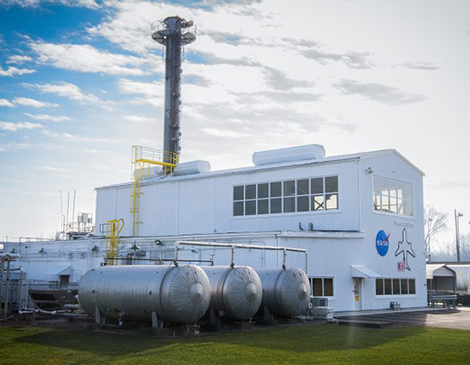The Artemis program is one of the most ambitious projects NASA has ever taken on — and some of its most vital developments are taking place right here in Cleveland.
If all goes as planned, by 2050, humans will not only have visited the moon again, not only have established a permanent presence across the moon’s surface, but humans will also have stepped foot on Mars’ dusty floors and maybe built a somewhat permanent presence there.
But the moon, seen as a launchpad to Mars, is the first step — a 238,900-mile rest stop before continuing your 34.6
million-mile, seven-month flight.
“Not only to Mars but maybe some other planets, too,” says Michael Barrett, director of Space Flight Systems Directorate at NASA Glenn. “This is way bigger than Apollo was, both in capability and in the intention to have a sustained presence on the moon, and to use it as that stepping stone for Mars.”
Here at Cleveland’s NASA Glenn Research Center, as well as Sandusky’s Neil Armstrong Test Facility, some of the world’s most capable test facilities, manufacturing abilities and brilliant minds are being put to use to get us there. Already, the Artemis I mission, where dummy passengers orbited the moon, saw the Orion Spacecraft take flight in November 2022. NASA Glenn was instrumental in testing and even building elements like the engine for that vehicle. A main component of the Gateway (a school bus-sized capsule that will serve as the lunar space station) called “solar electric propulsion” is also being developed at NASA Glenn. This should power and propel the spacecraft for as many as 15 years. The solar rays, which make the Gateway grow to about the size of a football field, were tested in Sandusky.
The next step is a launch in November that will see humans travel farther than we’ve ever been before. In 2025, humans will return to moon for the first time since 1972, and by 2029, the Gateway should be operating and in orbit.
In all, there are more than 3,000 scientists and technologists working on this project just in Northeast Ohio, creating almost $2 billion in economic impact every year.
“There’s only 10 NASA centers in the country,” says Barrett. “To have one in our backyard creates so many opportunities. It’s really exceptional."
We asked Barrett a few more questions about what it might mean for NASA's Artemis Program to be a success.
Cleveland Magazine: Let's start small. If everything goes as planned, what has the Artemis Program and NASA accomplished in terms of space travel by the year 2050?
Michael Barrett: So 2050, there have been human footprints on Mars. We have a permanent presence on the moon and maybe Mars, but we definitely have a semi-permanent robotic presence — not only of Mars but also maybe some other planets. We've put the first woman and person of color on the surface of the moon. We are learning how to live off the planet. We have developed new communication systems that can deliver a higher rate of data more accurately, which again, once we've done it in space, we turn around and then use the same systems here on Earth. But first, it's using the lunar surface and the lunar environment as that stepping stone and proving ground for the systems. So with these near-term Artemis missions that are really reestablishing our capability to get to the moon and expanding it. Apollo was really limited to the equator. Artemis needs to have access to the entire surface of the moon. So we'll be able to test new technologies, different power systems, different habitat systems for surfaces that feed-forward to those Martian emissions. Again, by 2050, the vision would be that there are human footprints on Mars, and we've begun to learn more about the Martian surface. We get great information from the rovers, but it's just not the same thing as having people there. So we'll learn a lot more about Martian history. We will have learned more about lunar history. And both of those planets tell us a lot about Earth's history. But Artemis is that first step.
CM: What are the benefits of going to the moon and Mars here on Earth?
MB: It's a great question because of course there's a great cost investment to all the work that we do. For one, we will literally rewrite
science books based on what we find. We will have probably created entirely new branches of science based on the discoveries that we have on these missions and the data that we bring back. By stretching the capabilities of our technology, we will
absolutely develop technologies that don't exist today and that will have terrestrial applications. We will develop power systems and communication systems that will be lighter will be able to be used on the surface of the earth. By
2050, we will have literally created materials that don't exist today to build the spacecraft and the systems that we need and then those materials will be in use on Earth for other systems. Glenn, particularly, has a history of doing that.
The other big thing that Artemis brings is the international collaboration. Even when we started this with the first launch last year, that was a big deal. I think in today's environment, it even hits home more. Things like the Artemis Accords, where the Netherlands will be the 30th country to sign it this week. That talks about international collaboration, peaceful purposes for the use of space, open sharing of data and science information. I think that piece of it will also have a long living benefit. But probably the biggest thing that will benefit us is the inspiration side of it. There have been lots of studies that have documented that when people watched Apollo, for that initial trip to the moon, it inspired them to go into a STEM field. It brings everyone along for the thrill of the exploration and that inspires them in their own occupations. There is almost an immeasurable return on investment.
CM: What would this permanent settlement on the moon look like?
MB: We have different options. In my opinion, by 2050, there'll be essentially a base camp, probably somewhere around the lunar South Pole. I think
your Antarctica reference is a good one. It might be a little bit larger, and we'll also probably have sister sites at other locations on the surface. So there's a lot of resources we believe that the South Pole of the moon, right, the water ice, and
there's some other advantages about being there. But from a science perspective, we definitely want to have global coverage. I mentioned that Apollo was limited because of the performance of the systems back then. Pretty much all the landings are equatorial
right around the center of the moon. And with the Artemis program now, we have SLS, Orion and the Gateway — that will be the lunar Space Station — the combination of those systems now along with the human landing system (HLS), the performance
and the capability will allow us to get basically anywhere on the moon. And so I do believe they'll probably be a base camp close to the South Pole. And then several science sites of interest with semi-permanent presence — maybe a permanent robotic
presence. And they will be all connected on a communications network, right, and maybe a power grid with maybe some cabling, but also maybe beaming power from one location to the next. Those are all the kinds of things that I talked about, as we're
working on those technologies could then come back to Earth Systems.
CM: Do you envision a time when humans can vacation to the moon?
MB: There are parts of the industry today that I would never have envisioned even 15 years ago. The commercial aerospace business is just booming — particularly in space. I think space tourism will be a real thing by 2050 when we look at it that way. Now, will they be spending most of their time in low Earth orbit like they do with the space station today? I think there'll be commercial space stations. Personally, I do think there'll be commercial hotels, right that are in low Earth orbit. I'm not sure how much it costs for a room and night, but I do think that there will be access to space for the populace. Will they make it to the surface of the moon by then? Maybe. The technology certainly will support it and enable it. I think it's a real possibility. And that's exciting, right? I mean, even working at NASA, right, the people that are actually astronauts are a small group, right? We love talking with them. We kind of live with their spacewalks through them. But the more access that commercial space, in particular, preceded by the government's investment in the technology and enabling the capabilities, I think that's also huge. I mean, it's hard to inspire someone more than actually being able to send them.
CM: Are we trying to escape planet Earth?
MB: So certainly, there are very prominent folks that identified that as part of their motivation, saying that we need to be a multi-planet species. And so, if you're going
to do that you have to take baby steps at some point. So this could be viewed as that. The challenge to be a multi-planet species is significantly larger than even just getting to Mars. Because even at Mars, it's not a natural habitat that supports
human life, but when we enable it with habitats and small cities and types of things, the answer is yes. So we have figured how to get there and understand the systems and the environments that are first. The other thing from the Earth's environment and climate change perspective. I mean, we have some very direct things that NASA right that we do, obviously, we have satellites that are Earth-observing satellites, and we measure carbon emissions and we measure water content.
So there are things that we do that but there are other indirect things. So the ability to do those observations also creates technologies, where the technologies I mentioned advanced materials that could end up sparking some things that
enable systems like carbon capture, or other systems in terms of cleanup of the atmosphere, right that we might not even have thought of yet. That's the piece of the science, the discovery science, that as we learn new pieces of science through the
exploration activities, and apply them here that some say it may it may bring solutions that we can't even think of today, because we don't have the scientific understanding. Until several years ago, we hadn't even had humans in orbit for that long.
Right. So I think that's true, but in terms of the species picking up and moving somewhere else, these are certainly baby steps.
From food to art to development, learn more about the Future of Cleveland.
For more updates about Cleveland, sign up for our Cleveland Magazine Daily newsletter, delivered to your inbox six times a week.




